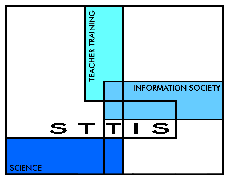
Science Teacher Training
in an Information Society
 Teaching about energy
Teaching about energy

 |
Science Teacher Training
in an Information Society |
 |
Workshop 1
|
Aims
BackgroundThe abstract pictures in this activity are intended to help pupils to focus on the idea that energy flows from hot to cold and that equilibrium is reached when temperatures become equal. Temperature is seen as a measure of the concentration of energy, so energy tends to spread out from where it is concentrated to where it is less concentrated. Thus this is similar to the process of diffusion, in which matter, rather than energy, spreads out.There are a set of 3 OHTs which introduce the conventions used in the abstract pictures. Each section on the OHTs has a question for the class to discuss and answer. In each section, there is a reminder of the important points to bring out in the discussion. Discussion with pupils is helped by having equipment to demonstrate the situations (needed are a beaker of hot water, an ice cube and a metal block). There follows an activity in which pupils need to use these abstract pictures to represent some everyday changes (‘Energy transfers in the kitchen’). This activity is best done as a small group activity, with discussion about the pictures, before pupils begin to write about the changes. Pupils should be encouraged to discuss the reasons why they make their selections, and there should be an opportunity for the whole class to discuss their selections after they have finished the activity. What to do1. Read through each of the OHTs on page 3, page 4 and page 5. Each picture shows an object and a background - the background represents the temperature of the room. The shading in these pictures shows how concentrated the energy is. Think about the question in each section and then turn to the notes about the section on page 2 which explains the conventions used. After you have done a few, you should begin to understand the conventions used and work out the answers before reading the notes.2. The activity based on these abstract pictures is on page 6 and page 7. It is best to cut out the pictures on sheet 2 so that they can put these on the spaces on the worksheets before deciding on a final answer. Note that in some cases, the names of the boxes on the sheet have been deliberately omitted. For example, this has been done in part D in order that pupils must decide whether to represent ice cubes in the left-hand box and lemonade in the right-hand box, or vice versa. 3. After you have completed the activity, you can check your answers on page 2. 4. Now think back over these activities, and consider the following questions:
|
| <<= Previous page | Introduction to Teachers' Workshop 1 | Next page =>> |